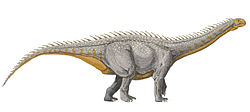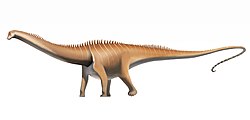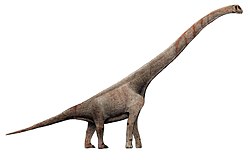| Dinodocus Temporal range: Early Cretaceous, | |
|---|---|
 | |
| Humerus of the holotype | |
| Scientific classification | |
| Kingdom: | Animalia |
| Phylum: | Chordata |
| Class: | Reptilia |
| Clade: | Dinosauria |
| Clade: | Saurischia |
| Clade: | † Sauropodomorpha |
| Clade: | † Sauropoda |
| Genus: | † Dinodocus Owen, 1884 |
| Species: | †D. mackesoni |
| Binomial name | |
| †Dinodocus mackesoni Owen, 1884 | |
| Synonyms | |
| |
Dinodocus (meaning "terrible beam") is a genus of sauropod dinosaur, named by Richard Owen in 1884, with the type species, Dinodocus mackesoni. The name is now usually considered a nomen dubium . The name was given to some fossil bones from the Lower Greensand Group (Lower Cretaceous) of Hythe, Kent, England, were formerly placed in the genus Pelorosaurus (Mantell, 1850 [1] ), but a review by Upchurch et al. (2004) concluded that Dinodocus is a nomen dubium . [2]











